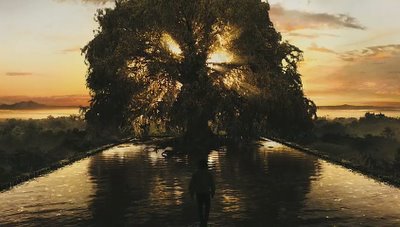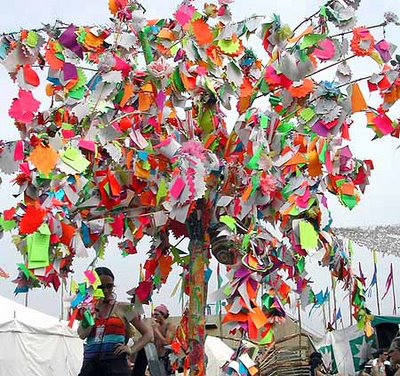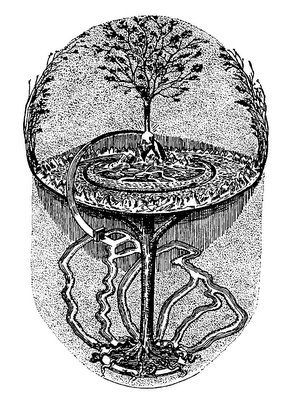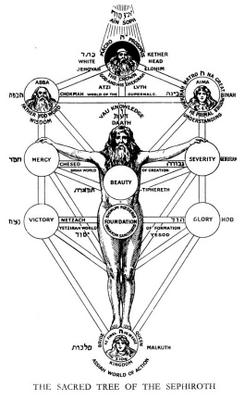Tree of Life and Knowledge
one of the most universal archetypes
Wednesday, November 23, 2005
Saturday, October 29, 2005
Monday, October 24, 2005
Fruit of Humility
The tree when it grows, it grows upwards. But when it is laden with fruit, it comes down. First it is attractive by its flowers, by its timber, by the other parts of its body and people try to destroy it for that. But when the fruits appear, they want to preserve it and the tree bends down with humility. It is very valuable. … One has to know to bend down towards Mother Earth, to be humble absolutely…. The mature fruit shows its humility by its weight. That is the Guru Tattwa weight.
Shri Mataji Nirmala Devi, 1983
Thursday, October 20, 2005
Monday, October 10, 2005
Friedrich von Hardenberg (Novalis)
„Die Bäume scheinen unter allen Pflanzen die edelsten, weil ihre unzähligen Individuen so sehr mittelbar nur noch an der Erde hängen und gleichsam schon Pflanzen auf Pflanzen sind. Die Sinne (sind) an den Tieren, was Blätter und Blüten and den Pflanzen sind. Die Blüten sind Allegorien des Bewußtseins, oder des Kopfs. Eine höhere Fortpflanzung ist der Zweck dieser höheren Blüte - eine höhere Erhaltung - Bei den Menschen ist es das Organ der Unsterblichkeit - einer progressiven Fortpflanzung - der Personalität. Merkwürdige Folgerungen für beide Reiche”
Novalis Werke. Studienausgabe. Hg. Gerhard Schulz. München 1989 (1969)
Ralph W. Emerson
A man is a bundle of relations, a knot of roots,
whose flower and fruitage is the world.
Ralph W. Emerson, 1803 - 1882
Paul Klee
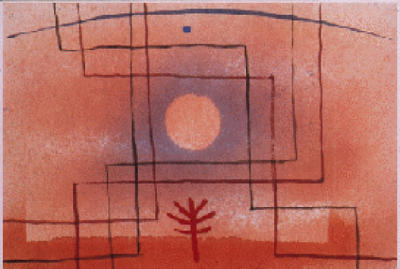
used the image of a tree to describe his understanding of the artist as a medium for the transformative process of nature. He observed that:
“From the roots the sap rises up into the artist, flows through him and his eyes. He is the trunk of the tree, seized and moved by the force of the current, he directs his vision into his work."
Paul Klee “Modern Art” 1924
Friday, October 07, 2005
Kabir says:
Do not go into the garden of flowers
O friend, go not there.
In your body is the garden of flowers.
Take your seat on the thousand petals of the lotus
and there gaze upon the infinite beauty.
There is a strange tree,
which stands without roots,
bears fruits without blossoming.
It has no branches and no leaves.
It is Lotus all over.
Two birds sing there:
One is the Guru and the other the disciple.
The disciple chooses the manifold fruits of life
and tastes them
And the Guru beholds him in joy.
Lord Ganesha

In our gardens, Lord Ganesha sends His power through fruits and vegetables, the ones that grow above the ground, to permeate our nerve system with wisdom, clearing obstacles in our path when eaten. The growers of them treat it like they would care for Ganesha in His physical form.
Hindu Deva Shastra, verse 438, Nature Devas
Sankaracharya
Of the tree of Samsara ignorance is the seed, the identification with the body is its sprout, attachment its tender leaves, work its water, the body its trunk, the vital forces its branches, the organs its twigs, the sense-objects its flowers, various miseries due to diverse works are its fruits, and the individual soul is the bird on it.
This bondage of the non-Self springs from ignorance, is self caused, and is described as without beginning and end. It subjects one to the long train of miseries such as birth, death, disease, and decrepitude.
This bondage can be destroyed neither by weapons nor by wind, nor by fire, nor by millions of acts - by nothing except the wonderful sword of knowledge that comes of discrimination, sharpened by the grace of the Lord.
One who is passionately devoted to the authority of the Srutis acquires steadiness in his Svadharma, which alone conduces to the purity of his mind. The man of pure mind realizes the Supreme Self, and by this alone Samsara with its root is destroyed.
Sankaracharya, Vivekacudamani
Upanishads
Samsara is like a fig tree but with its roots above in the heavens.
The continuous and practically endless chain of birth, craving (kama) for sensual pleasures in this world and in the other worlds, activities (karma) to achieve these pleasures and objects of pleasure, the merit (punya) and the demerits (papa) resulting from such activities and rebirth is due to avidya or ignorance and is referred to as the fig tree of samsara. Because all life emanates from the all pervading Brahman, this huge tree has its roots above in the heavens. Just as the fig tree grows from a small seed, the tree of samsara grows from a craving for outside objects of pleasure however small and this bondage of samsara can be rooted out by knowledge or vidya just as the huge fig tree can be cut and destroyed.
Upanishads, Chapter 2
quoted from: A synopsis of Upanishads
English transalation of a Sanskrit book Advaiata
Vedantha Sara by P.S. Narasimhan (Late) of Geneva).
Publisher: Mr. V.M. Lakshminarayanan,
36/2 (New No. 91), Promenade Road, Frazer Town, Bangalore 560 005, India.
Zen Koan
A monk asked Joshu, "What is the meaning of Bodidharma's coming to China?" Joshu said,
"The oak tree in the garden."
A monk asked Zhaozhou, "What is the living meaning of Zen?." Zhaozhou said,
"The cypress tree in the yard."
Case 37 from the Mumonkan (Wumenguan), A Traditional Collection of Zen Koan
'Joshu, Chao-chou, Zhaozhou' are different spellings of the name of a Chinese Chan (Zen) Teacher
Wednesday, October 05, 2005
Old Testament
And on the banks, on both sides of the river, there will grow all kinds
of trees for food. Their leaves will not wither nor their fruit fail, but
they will bear fresh fruit every month, because the water for them
flows from the sanctuary. Their fruit will be for food, and their
leaves for healing.
Old Testament, Ezekiel 47:12
Inverted Tree of Life
According to legend the tree of life has its roots in heaven. It is there that the Creator resides and hence from there the roots originate. The torah is likened to the tree of life as are the ten sephirot.
" In Paradise stands the tree of life and the tree of knowledge, the later forming a hedge around the former. Only he who have cleared a path for himself though the tree of knowledge can come close to the tree of life, which is so great that it would take a man five hundred years to travel the distance equal to the diameter of the trunk, and no less vast is the space shaded by its crown of branches. From beneath it flows forth water that irrigates the whole earth."
From Ginzberg's Legends of the Jewish, volume I, page 70:
www.hamsa.com/index.html
Persians and Assyrians
In the religion of the Medes and Persians the cult of trees plays an important part, and with them, as with Assyrians, the symbol of eternal life was a tree with a stream at its roots. Another object of veneration was the sacred miracle tree, which
within itself contained the seeds of all.
M. L. Gothein, A History of Garden Art, 1928
Islam
Dies Universum ist ein Baum -
der Mensch ist seine Frucht.
Die Frucht ist ja der wahre Zweck -
denk’ nicht mehr an den Baum
Alif: Allah ist wie der Jasminzweig, den der Meister mir ins Herz gepflanzt hat. - o Hu! (...)
Er verbreitet inneren Duft, als er dem Blühen nahekam - o Hu!
Möge der tüchtige Meister lange leben. - sagte Bahu - , der diese Pflanze gepflanzt hat. - o Hu!
Schimmel, Annemarie: Mystische Dimensionen des Islam. Die Geschichte des Sufismus. München 1992. p.270
Psalmen aus Qumran
Ich will dich, Herr, lobpreisen!
Denn du hast mich bestellt
Zum Ursprung vieler Bäche Im trockenen Land
Und hast mich zur Quelle in der Wüste gemacht
Und zum Wasserspender eines Gartens.
Du hast Wacholder, Buchsbaum und Zedern zusammen gepflanzt
zu deiner Herrlichkeit.
Und an verborgener Quelle
sind Lebensbäume versteckt
inmitten der anderen Bäume am Wasser.
Und ihre Aufgabe ist, Sprosse zu treiben,
damit der Garten ewig besteht.
Und ehe sie treiben, sollen sie Wurzeln schlagen
Und ihre Wurzeln zum Wasserlauf ausstrecken.
Und jeder lebendige Baum richtet seinen Wurzelstock
zum sprudelnden Wasser hin
Und dies wird zu Quelle für alle Zeit.
Und von seinen jungen Blättern
nähren sich alle Tiere des Waldes,
und über seine Wurzelarme gehen alle,
die des Weges kommen.
Und seine Zweige sind Nistplatz für alle Vögel.
Die Bäume am Wasser werden größer als er,
weil sie zusammen stehen.
Doch zum Flussbett hin
richten sie ihre Wurzeln nicht.
Der heilige Spross aber
Treibt Blüten hervor, so dass er nicht vergeht,
auch wenn er verborgen ist, missachtet und unerkannt.
Es bleibt sein Geheimnis,
wer er eigentlich ist.
Aber du, Gott, hast eine schützende Schale gebildet um seine Frucht
Durch geheimnisvolle wunderbare Mächte
Und durch heilige Engel
Und die blitzende Flamme,
damit niemand an die Quelle des Lebens gelangt
und wie die ewigen Bäume vom heiligen Wasser trinkt
und seine Früchte wachsen lässt
wie auch die Bäume des Himmels.
Denn wer so ausgeschlossen bleibt,
sieht ohne zu erkennen,
er macht Pläne, ohne dass er sich verlassen könnte
auf die lebendige Quelle.
Aber ich bin den Fluten reißender Flüsse ausgesetzt,
und sie haben ihren Schlamm auf mich geworfen.
Doch du, mein Gott, machst meine Worte
erquickend wie Regen am Morgen für alle, die durstig sind
und zu einer Quelle sprudelnden Wassers,
die nicht lügt.
Soll ich den Himmel aufschließen.
meine Worte versickern nicht.
Sondern werden zum mächtigen Wasser,
zu reißendem Strom und zu grenzenlosem Meer.
Plötzlich sprudelt hervor, was im Verborgenen war.
Aber durch mich
Hast du eine Quelle für sie aufgetan,
so dass die Bäche fließen.
Ich richte mich nach festem Plan und pflanze die Bäume je nach Sonnenstand, dass herrliche Zweige herauskommen.
Wenn ich mit meiner Hand Wassergräben für sie ziehe
Schlagen sie Wurzeln
In hartes Felsgestein
Und ihr Stamm steckt in der Erde und bleibt in der Sommerhitze kräftig.
Klaus Berger
Quell Verlag, Stuttgart 1994
Ziterert nach
1QH 8,1-39 Hebr. Text nach Lohse, Texte 128-130
Tuesday, October 04, 2005
World Tree in European Paganism
"...the two most widespread world images in the archaic imagination were the mother goddess and the "world tree."
Mark Dalton, The Recurring World Tree in European Paganism
http://www.widdershins.org/vol9iss1/04.htm
Tree of Life Quilt

Tree of Life Quilt - watercolor © Helen Klebesadel
Many organisations concerned with holistic health, ecology and women's organisations use the tree of life in their logo.
The cover illustration for the home page of www.matrifocus.com for example uses an image representing a tree of life quilt, referring to the ancient motive of folk handicraft and its tradition.
www.matrifocus.com is a seasonal ezine for women and others interested in Goddess Lore and Scholarship, Goddess Religion (ancient and contemporary), Feminist Spirituality, Cosmology and Women's Health.
Shaker Tree of Life

The original Shaker design of the Tree of Life was created by artist Hannah Cahoon in 1854. The Tree of Life was first seen by the artist in a vision she described as "a draft of a beautiful tree pencil'd on a large sheet of white paper ... I have since learned that this tree grows in the Spirit Land... I entreated Mother Ann to tell me the name of this tree: which she did by moving the hand of a medium to write twice over, Your Tree is the Tree of Life." The Tree of Life became a symbol of the Shakers' unity.
Életfa - Hungarian Tree of Life

Életfa," which means "Tree of Life," is an archaic Hungarian folk art symbol. It consists of a tree trunk adorned by branches and flowers, reaching towards the heavens, representing the hope for eternal life. This symbol is used as an ornament at major occasions such as weddings, christenings and funerals. In this way, the symbolic tree witnesses the passing of generations, linking together all Hungarians.
Életfa is also the name of one of the premier Hungarian folk band.
Mircea Eliade
The sacred tree, the sacred stone are not adored as stone or tree; they are worshipped precisely because they are hierophanies, because they show something that is no longer stone or tree but sacred, the 'ganz andere' or 'wholly other.'
Mircea Eliade, Myths, Dreams and Mysteries
The Sacred Tree
Among archetypal images, the Sacred Tree is one of the most widely known symbols on Earth. There are few cultures in which the Sacred Tree does not figure: as an image of the cosmos, as a dwelling place of gods or spirits, as a medium of prophecy and knowledge, and as an agent of metamorphoses when the tree is transformed into human or divine form or when it bears a divine or human image as its fruit or flowers.
Christopher and Tricia McDowell, The Sanctuary Garden, 1998, p 128
Black Elk

Then I was standing on the highest mountain of them all, and round
about beneath me was the whole hoop of the world. And while I stood
there I saw more than I can tell and I understood more than I saw; for
I was seeing in a sacred manner the shapes of all things in the spirit,
and the shape of all shapes as they must live together like one being.
An I saw that the sacred hoop of my people was one of many hoops
that made one circle, wide as daylight and as starlight, and in the
center grew one mighty flowering tree to shelter all the children of
one mother and one father. And I saw that it was holy.
Black Elk Speaks, The Great Vision, 1932, p. 36
Black Elk Speaks, published by Neihardt evolved from interviews with Oglala Sioux Holy Man Nicholas Black Elk. "Within a half hour, after I met him, Black Elk had chosen me as his spiritual son." Neihardt recalls, "and he seemed not only to know that I was coming but had expected me a long time." The universal symbolism of this book made it a favorite of scholars such as Carl Jung and Josesph Campbell.
Crazy Horse
"... I see a time of Seven Generations when all the colors of mankind will gather under the Sacred Tree of Life and the whole Earth will become one circle again ... I salute the light within your eyes where the whole Universe dwells. For when you are at that center within you and I am that place within me, we shall be one."
Statement by Chief Crazy Horse, smoking the holy pipe for the last time four days before he was killed.
Monday, October 03, 2005
William Butler Yeats
Beloved, gaze in thine own heart,
The holy tree is growing there;
From joy the holy branches start,
And all the trembling flowers they bear.
The changing colours of its fruit
Have dowered the stars with metry light;
The surety of its hidden root
Has planted quiet in the night;
The shaking of its leafy head
Has given the waves their melody,
And made my lips and music wed,
Murmuring a wizard song for thee.
William Butler Yeats, The Two Trees
Abraham Lincoln
Character is like a tree and reputation like a shadow.
The shadow is what we think of it; the tree is the real thing.
Pablo Neruda
Wakening from the dreaming forest there, the hazel-sprig
sang under my tongue, its drifting fragrance
climbed up through my conscious mind
as if suddenly the roots I had left behind
cried out to me, the land I had lost with my childhood -
and I stopped, wounded by the wandering scent.
Frank Lloyd Wright

The "Tree of Life" window from the Darwin D. Martin House in Buffalo, ca. 1905, was fabricated by the Linden Glass Co. This pairing of art glass panels, designed for different areas of the Martin house, shows how Wright redefined the boundary between interior and exterior space and explores his revolutionary use of color and light in architecture.
